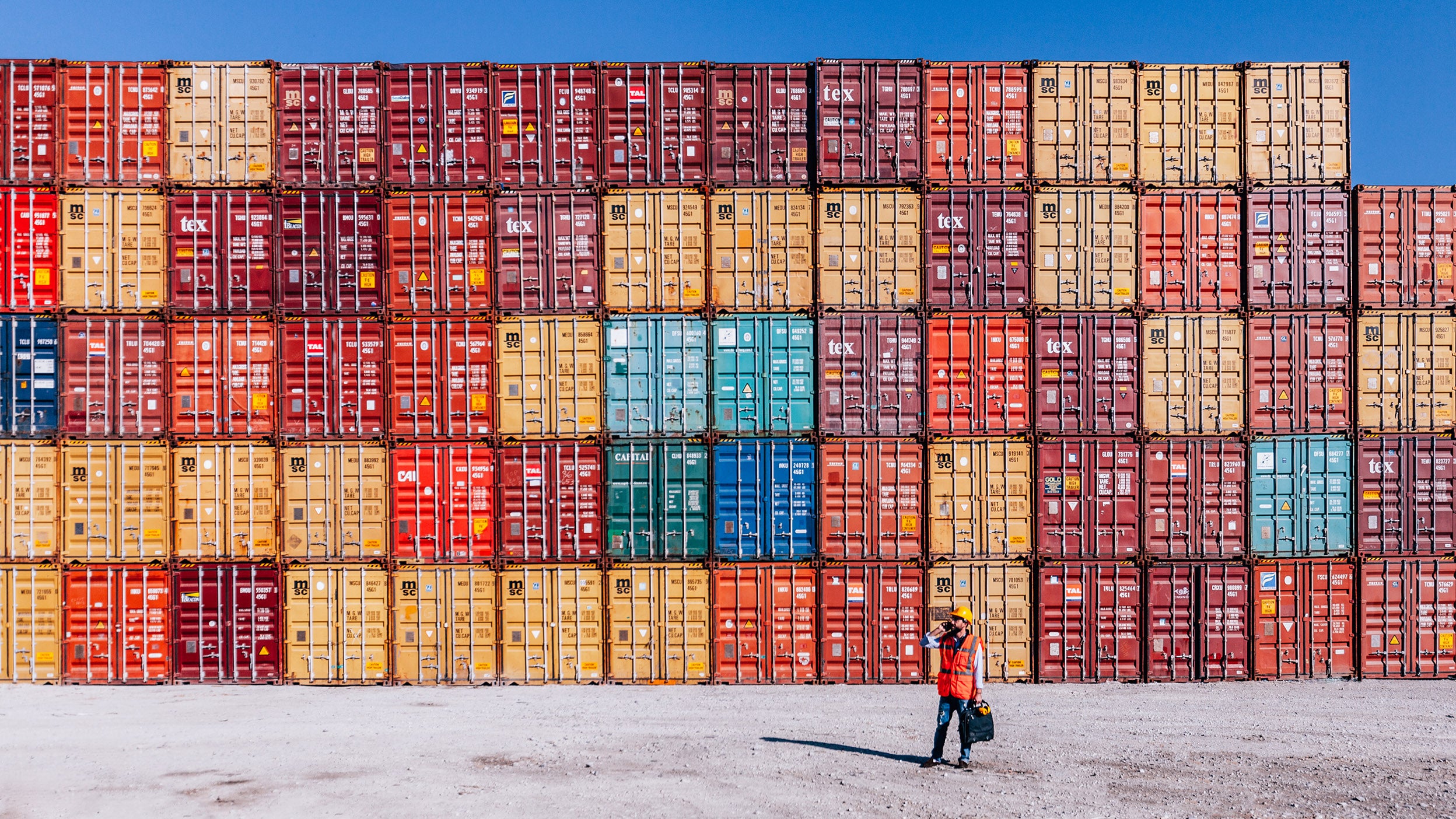
Will high tariffs push the US into recession?
As a trade war rages, a massive market sell-off in the US and around the world raises many questions for investors.

US President Donald Trump unveiled sweeping new tariffs in his “Liberation Day” announcement on April 2.
We anticipate significant volatility and downward pressure on risk assets in the near term.
Canada and Europe look to increase spending, which would be expected to benefit their economy and industries.
US President Donald Trump unveiled sweeping new tariffs in his “Liberation Day” announcement on April 2, adding to the list of tariffs that were already announced in the first several weeks of his second term. The April 2 tariffs came in two parts1:
Responses started shortly after Trump’s announcement. European Commission President Ursula von der Leyen said: “We are already finalising the first package of countermeasures in response to tariffs on steel, and we are now preparing for further countermeasures to protect our interests and our businesses if negotiations fail.”3
To help put the escalating trade wars into perspective, we asked a variety of Invesco’s global experts for their views. This is an evolving story, and we will continue to update with more perspectives.
Invesco Global Market Strategy Office
The risk of recession increases every day that these high tariffs are in force. We anticipate significant volatility and downward pressure on risk assets in the near term. The risk of stagflation in the US has also increased.
The good news is that there are staggered implementation dates, which support the theory that these tariffs are being used as a bargaining tool and are not expected to be long-term in nature. And some countries have indicated they will reduce the tariffs they apply to US imports.
In the short term, there will likely be significant downward pressure on US stocks and stocks of countries with high tariffs. We expect the US dollar to weaken as growth slows and demand for dollar-denominated assets declines with an anticipated reduction in the trade deficit.
We anticipate gold will continue to rise on geopolitical and economic policy uncertainty. We think European equities and Chinese equities could perform well, assuming fiscal stimulus will help support economic growth.
For those with a short time horizon, we believe it would be prudent to be risk off. Those with a longer time horizon may consider taking advantage of sell-offs in order to increase their exposure to risk assets, taking cash off the sidelines, and remaining well diversified.
Oliver Collin, Co-Head of UK and European Equities
What do Trump’s tariff announcements mean for Europe? In terms of gross domestic product (GDP), it’s been estimated that the 20% tariff increases for Europe could largely offset the positive impact expected from Germany’s recent spending announcements in 2025.
To us, that appears a bit on the aggressive side, but clearly there will be a sizeable impact this year if there’s no renegotiation. That said, it was partially because of the US becoming more adversarial in the first place that Europe started to put in place additional spending plans – the ReArm defence plan and German Infrastructure/Defence plan.
Also, don’t forget that this is a step change in tariff levels, meaning that it is largely a one-year effect. Hence, we expect a short-term headwind, but as demand/supply adjusts to higher prices, it should have a muted impact thereafter. A speedy resolution is therefore key.
For Europe, this only highlights the importance of becoming more self-sufficient. The severity of the tariff increases is only likely to reinforce this message. Thankfully, Europe is rising to the challenge. This means we’re confident that the medium to long-term outlook for GDP is a good deal better than it’s been since the Global Financial Crisis.
One of the key problems in the last decade or so has been the lack of government investment, particularly in Germany. But we expect decent growth to continue in Southern Europe, and — putting the tariff impact to one side — we expect Germany’s fiscal plans could add 1%-2% to the rate of GDP growth in due course. So, to us, it looks like at least two-thirds of Europe is well placed to grow in the medium term.
Martin Walker, Co-Head of UK and European Equities
The noise about tariffs will no doubt echo for months to come. The immediate focus is on the direct effects of bilateral trade with the US — machinery and transport equipment, chemicals, and miscellaneous manufacturers look to be among the key industries affected, while utilities and real estate are not impacted by bilateral trade.
However, the longer term will depend on the 2nd and 3rd order effects. For example, any excess capacity in plastic toys produced in China may reduce the cost of Santa’s Christmas sack to UK households.
Although there is slight relief that the UK is likely to be less directly affected than many countries, it’s important to remember that the UK equity market is not the same as the UK economy – as of 31 March 2025, around 50% of the revenues of the FTSE All-Share Index are from the rest of the world (ex-US). It’s also important to note that the impact of tariffs in the US might provide opportunities to well-positioned companies.
Paul Syms, EMEA ETF Head of Fixed Income & Commodity Product Management
The initial reaction to Trump’s tariff announcement was risk-off as the tariffs were higher than most expected. But, while ‘safe haven’ assets such as cash and government bonds are likely to be favoured near term, valuations on credit are starting to look less expensive than the levels seen in recent months.
While it may be a little early for investors to start adding risk, in our opinion, credit markets are beginning to look more attractive. Any further spread widening and a clearer view of the impact tariffs will have on growth could start to tempt investors to increase risk once more by buying investment grade and high yield — particularly if the economic outlook starts to look more positive.
Brian Levitt, Global Market Strategist
The hopes heading into “Liberation Day” were twofold: first, that the tariffs wouldn’t be as high as feared, and second, that clarity would be restored to markets. Unfortunately, neither hope came true.
The uncertainty for markets persists as we await to learn which countries will pursue retaliatory tariffs on the US and which will seek to make concessions to the Trump administration in exchange for lower tariffs.
Tariffs lead to less optimal economic outcomes, plain and simple. While we can debate whether they are worth the hit to corporate profitability and the increase in prices of consumer goods, someone ultimately pays for them.
I anticipate the US economy to further slow, and the longer the tariffs are in place, the greater the risk to the US business cycle. Compounding the problem, rising prices may prevent the US Federal Reserve from responding aggressively to counteract the economic weakness. It’s difficult to make a compelling case for US equities here unless a meaningful shift in trade and monetary policy emerges.
Brian Tidd, Senior Portfolio Manager, Canadian Equity Income
US tariffs on Canadian exports (autos, steel, lumber, etc.) will have a profound impact on the Canadian economy. It will take time to establish new trading partners, and for many goods (such as oil), the US is destined to remain Canada’s primary export market.
Some industries will be hit harder than others, and we anticipate the pain will reverberate through many communities. For example, the city of Windsor (which sits across the river from Detroit) could be devastated by tariffs and/or any wind-down in Canadian auto production.
Canada will need to focus on encouraging new business investment, improving productivity, fostering innovation, and broadening trade and security alliances. There is now a newfound sense of urgency in Canada to develop its vast natural resources, invest in infrastructure, and increase domestic military spending in order to support the economy for years to come.
I expect these expenditures to be positive for the Canadian industry and may present interesting long-term growth opportunities for select Canadian businesses.
Patrick Garvin, Product Director, Asia Equities, ex-Japan
If fully implemented, these tariffs are likely to be a negative shock for global trade. There is greater recession risk for many countries if tariff rates stay on for an extended period of time, with downward revisions to earnings expectations likely.
Rather than retaliate or negotiate, policymakers may use fiscal stimulus measures such as consumption subsidies and corporate tax breaks to support exporters, which is more likely to be a positive for global growth than a catalyst for bringing back US manufacturing jobs.
The proposed tariffs are also likely to force a reshuffle in global trading patterns and may also force greater co-operation between regional trading partners.
Whatever happens next, tariffs are a lose-lose proposition, in our view, but Asian companies have been managing this risk for several years now, and intra- Asian/emerging market trade has been increasing despite global trade stagnating.
Good companies have been able to find other markets to export to. Some companies may even benefit if it means less competition from weaker players, and if they are better at reorganising their supply chains.
Market sentiment feels negative right now, but positive narratives may yet emerge.
Kathy Kriskey, Head of Alternatives Product Strategy, ETFs & Indexed Strategies
The reciprocal tariffs recently implemented by the Trump administration are impactful for many commodities from all three sectors: energy, metals, and agriculture.
Although crude oil and gold are not subject to reciprocal tariffs, these markets are still feeling pressure as concerns around the global economy and demand for raw materials escalate.
These tariffs were more aggressive than analysts expected and are viewed as ceilings that might be lowered as negotiations between Trump and his international peers increase.
Commodities tend to have an inverse relationship to the US dollar, but we have seen weakness in both. China is the biggest buyer of commodities, and the high tariffs imposed on this country hurt this sector.
There is also concern around the grains market in terms of possible retaliation, as China may continue to lower its purchases of US grains like soybeans and corn. But it’s important to remember that one big weather event could dwarf the tariff impacts on grains.
Industrial metals are also feeling pressure, even though copper tariffs are still part of a Commerce Department investigation and likely to start at the end of April, at the earliest. US copper recently hit an all-time high, with many market participants sending copper from the London Metals Exchange (LME) to the US to pre-position for this expected tariff.
Another factor to consider is the risk of stagflation, as the tariffs may lead to higher inflation and slower economic growth. Gold and broad-based commodities tend to hedge stagflation.
Nick Kalivas, Head of Factor and Core Product Strategies, Invesco ETFs
In the wake of Trump’s tariff announcement and the global response, policy uncertainty is likely to remain present, and volatility is expected to be elevated. The aggressive implementation of tariffs also puts expectations for accelerating profit growth in 2025 at risk and could push out a profit recovery.
In my view, all this reinforces the case for owning defensive factors such as low volatility, quality, and yield. Furthermore, the tariff picture could change quickly, so the potential to participate in market strength while mitigating or dampening downside risk should be attractive, in my opinion. The tariff saga is a reminder that factors can be used both tactically and strategically to help create a more durable portfolio.
1 Source: Wall Street Journal, “Tariff News, April 2, 2025: Trump Unveils Sweeping Levies in Stark Shift in Trade Policy,” April 2, 2025
2 Source: CNBC, “Trump’s tariffs risk a global trade war, as leaders plan next steps,” April 3, 2025
3 Source: Politico, “EU ‘prepared’ to retaliate against Trump’s 20 percent tariffs,” April 3, 2025

As a trade war rages, a massive market sell-off in the US and around the world raises many questions for investors.

In our monthly market roundup for February, Invesco experts give a rundown of a mixed month for global equity markets, as well as an update on fixed income markets.

With policy uncertainty rattling markets and consumer sentiment, it’s important to remember the market's long-term growth throughout its history.


Sign up to receive the latest insights from Invesco’s global team of experts and details about on demand and upcoming online events.
The value of investments and any income will fluctuate (this may partly be the result of exchange rate fluctuations) and investors may not get back the full amount invested.
Data as at 4th April 2025.
This is marketing material and not financial advice. It is not intended as a recommendation to buy or sell any particular asset class, security or strategy. Regulatory requirements that require impartiality of investment/investment strategy recommendations are therefore not applicable nor are any prohibitions to trade before publication.
Views and opinions are based on current market conditions and are subject to change.
EMEA4379083